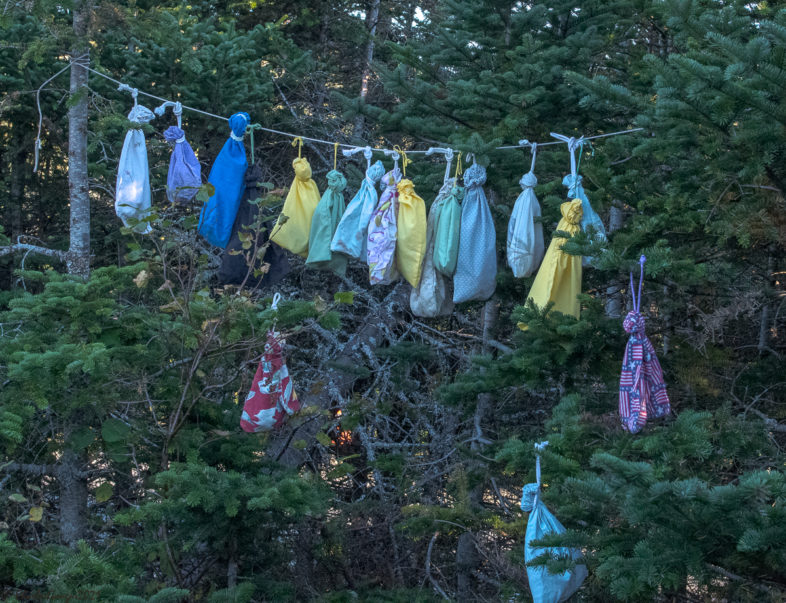
The VCE avian “clothesline” on Mt. Mansfield was festooned with bird bags on 20-21 September 2021, as migrants filled our mist nets. The number of birds captured often exceeded the availability of bags, some of which held 3-4 kinglets simultaneously! © Charles Gangas
Tiny feathered gems filled mist nets and ushered in the autumnal equinox on Mt. Mansfield to conclude VCE’s 30th field season. Scarcely weighing as much as a nickel, Ruby-crowned and Golden-crowned Kinglets utterly stole the show during our final banding session of 2021. Rarely visible as they danced along the ridgeline, these diminutive migrants kept the VCE crew on its toes from the time we set up nets on the evening of 19 September until we closed them for the season at midday on the 21st—an astonishing 101 of the two species passed through our hands!
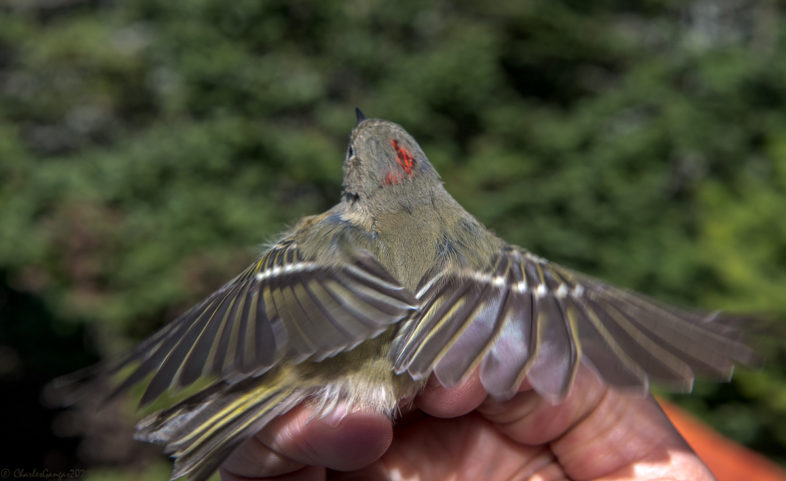
A demonstrative male Ruby-crowned Kinglet, one of 55 individuals banded by VCE on the Mt. Mansfield ridgeline, 19-21 September 2021. © Charles Gangas
Although our primary banding season on Mansfield concludes in early August each year, we invariably return in mid-September, both to intercept Bicknell’s Thrushes (BITH) before their southward departure and to sample the fall migration. This annual visit did not disappoint. Weather was spectacular, with warm, clear and mostly calm conditions. A full moon and cloudless skies yielded unobstructed views of evening’s simultaneous moonrise and sunset, followed by dawn’s moonset and sunrise. It doesn’t get any better than that!
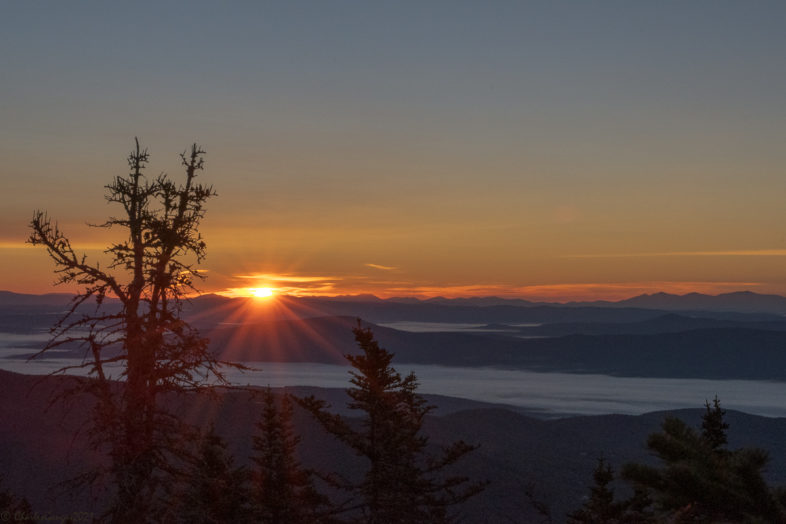
Sunrise from the Mansfield ridgeline, with clouds clinging to the Stowe valley below, 20 September 2021. © Charles Gangas
And, the birds put on an equally memorable performance. In addition to kinglets, Blackpoll and Yellow-rumped (Myrtle) warblers made strong showings in our nets. Most of these were undoubtedly transients, but we captured two adult (AHY, or after hatching-year) male Blackpolls that were known summer residents—they’ll be off very soon for their epic non-stop transoceanic flight to northern South America. We were a bit surprised not to capture more boreal migrants, but we ended up with a fine array of 21 species, and no complaints! Crowd-pleasers included an immature (HY, or hatching-year) male Sharp-shinned Hawk, a Winter Wren, and a Magnolia Warbler.
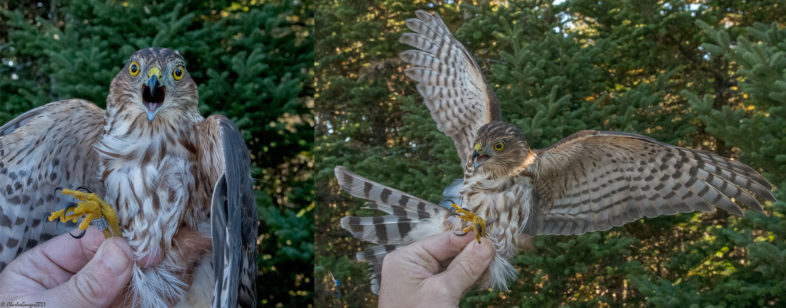
An immature male Sharp-shinned Hawk had no qualms about expressing his concerns over the banding process. 20 September 2021, Mt. Mansfield. © Charles Gangas
Our final tally of 222 individuals, while lower than expected for diversity and lacking any real surprises, was impressive:
Sharp-shinned Hawk — 1 HY male
Downy Woodpecker — 1 HY
Blue-headed Vireo — 1 HY
Blue Jay — 4 HY
Ruby-crowned Kinglet — 56 (41 HY, 15 AHY)
Golden-crowned Kinglet — 45 (43 HY, 2 AHY)
Red-breasted Nuthatch — 5 (4 HY, 1 AHY)
Winter Wren — 1 HY
Bicknell’s Thrush — 14: 8 new (7 HY, 1 AHY); 1 return AHY banded on 9/18/20, 5 within-season AHY recaptures (4 males, 1 female)
Swainson’s Thrush — 3 new (2 HY, 1 AHY)
Hermit Thrush — 3 HYs still in juvenal plumage
American Robin — 1 HY
Dark-eyed Junco (Slate-colored) — 9 (7 HY, 2 AHY)
White-throated Sparrow — 12 (10 HY, 2 AHY)
Ovenbird — 1 HY
Bay-breasted Warbler — 1 AHY male
Magnolia Warbler — 1 HY
Blackpoll Warbler — 27 (25 new [13 HY, 12 AHY], 2 within-season AHY male recaptures)
Black-throated Blue Warbler — 4 new (3 HY, 1 AHY)
Yellow-rumped Warbler (Myrtle) — 31 new (26 HY, 5 AHY)
Black-throated Green Warbler — 1 AHY male

Immature Blackpoll Warblers (left), the quintessential “confusing fall warbler”, contrast markedly with immature Black-throated Blue Warblers (right), arguably the most distinctive wood warbler in autumn (right). 21 September 2021, Mt. Mansfield. © Charles Gangas
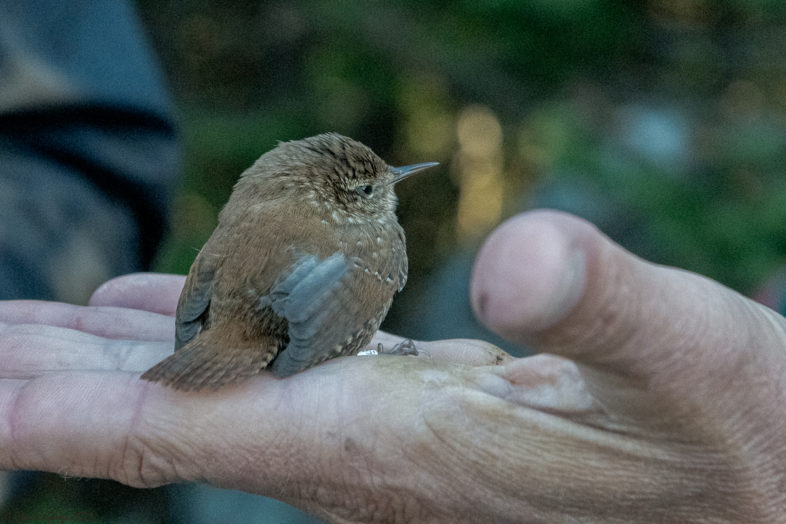
A banded Winter Wren ponders its options before heading back to the balsam fir thickets on Mt. Mansfield, 20 September 2021. © Charles Gangas
True to form, BITH were present and accounted for on the ridgeline, only days before most will depart Several individuals called or sang at dawn and dusk, and 14 found their way into our mist nets. We banded 8 new birds (7 HYs), recaptured an adult of unknown sex whose only previous encounter with us was exactly one year ago, and reacquainted ourselves with 5 adults from our June-July banding season. Of these latter birds, two (a male and female) carried GPS tags that we had affixed weeks earlier, and both were in robust condition, having successfully completed their post-breeding molt. A third male, which we had banded on 2 June (a week before we started applying GPS tags) and not encountered since, will now carry a tiny backpack down to his Caribbean winter quarters (and hopefully back next spring). Our final GPS tag—#36 of the season—went on the new adult, which we assume was a local breeder who somehow evaded our nets this part summer but will return next May to furnish his precious spatial data. Now, these 36 backpack-toting BITH need to avoid storms or other perils during their southward passage, survive the challenging winter months on Hispaniola, Cuba, Jamaica, or Puerto Rico, and successfully navigate the return trip to Mansfield.
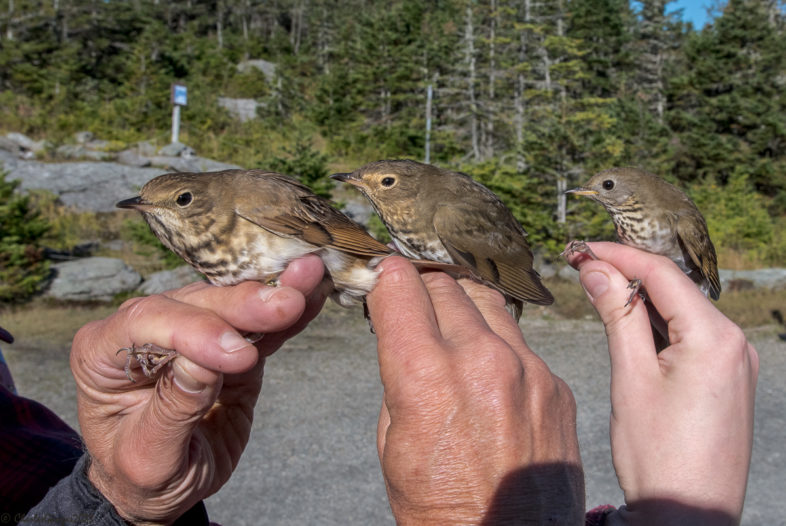
A challenging-to-identify trio of Catharus thrushes on Mt. Mansfield, 20 September 2021. From left: Hermit, Swainson’s and Bicknell’s. © Charles Gangas
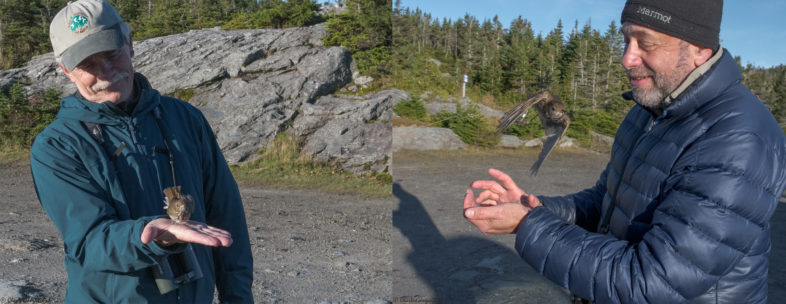
VCE Advisory Council member Rick Bowe (left) releases a GPS-tagged Bicknell’s Thrush, while VCE friend and birding enthusiast David Tobias (right) experiences a rare BITH release head-on towards the camera. © Charles Gangas
Finally, we salute and thank as always the numerous people who visited and contributed to VCE’s milestone 30th season on Mansfield. From our dedicated, capable field staff—headlined by Kevin Tolan and Nathaniel Sharp—to our volunteer banders (Chris Hansen deserves a special shout-out), to our eager interns and banding apprentices, to our many friends and supporters, to our board and administrative staff, it was a true team effort. We already look forward to season #31 next June, and to seeing many of you on the ridgeline!

The future of bird conservation, south and north: VCE friend Prisca Felix (left) from Haiti releases a banded Bicknell’s Thrush (which may soon be in her country), and VCE AmeriCorps member Abbie Castriotta (right) sends off a banded Blue Jay. 20-21 September 2021, © Charles Gangas

This is awesome. Thank you all for your work and knowledge.
Hi Chris – congratulations on a great season. As one who bands in Oct along the coast at Island Beach State Park, NJ, your RCKI age ratio of 41/15 is astonishingly different from what we experience where 90-95% are HY, different migration strategies for the 2 age classes? Your GCKI ratio more nearly matches that along the coast. Your Blkpoll ratio departs strongly toward AHYs compared to strongly HY along the coast.
Re your 3-thush photo, I think the order should be HETH/SWTH/BITH rather than SWTH/HETH/BITH.
So much to be proud of in this state, but I’d place the knowledge base and the sheer dedication of VCE scientists and staff to showing us the glory within the borders of Vermont (and far away, too!) in the top tier. Thank you for the words and photos, and the Vermont values you embody,
What a wonderful project! Thank you for documenting all the beauty and for all your work!
Your reports are the next best thing to being atop of Mansfield.
The photos by Charles Gangas give us a vicarious view of the birds.
Thanks to all!
You all do such a wonderful job! I will never forget having the opportunity to join you several years back…holding the saw-whet owl was one of my all time wow moments!
The tiny wren melted my heart…precious.
Great Blog entry Chris!
I particularly appreciate the Catharus thrush photo. A rare opportunity to differentiate their subtle, and not so subtle field marks. I was particularly struck by how well it illustrated
how much smaller a bird Bicknell’s is.
We’ll be keeping an eye out for them as they pass through CT!